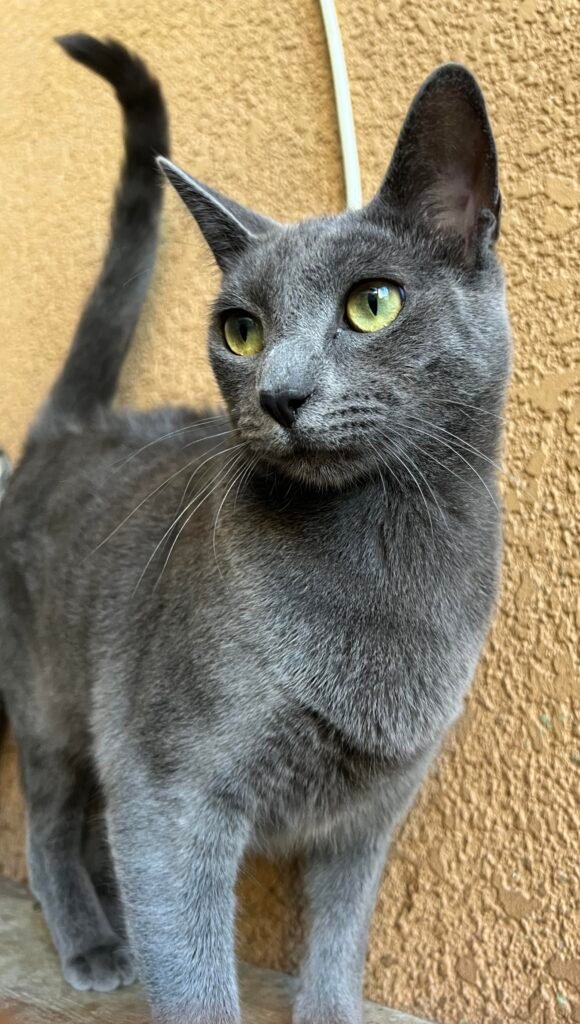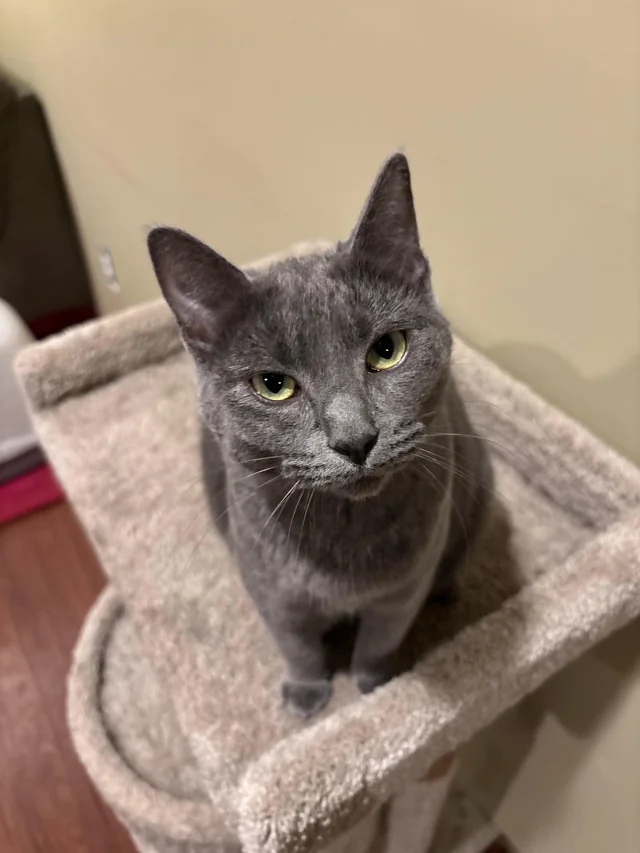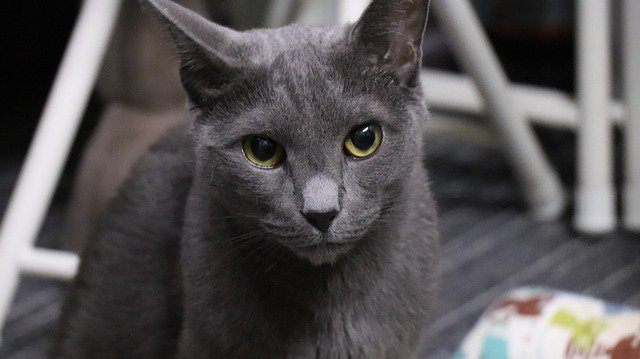Russian Blue
The Russian Blue cat is a distinctive breed known for its elegant appearance and charming personality. This breed is recognizable by its striking bluish-gray coat, which is short and dense, providing both warmth and soft touch. The unique coloration often leads to a silvery sheen, especially when seen in bright light. In addition to its beautiful coat, the Russian Blue has vivid green eyes that stand out against its fur, enhancing its overall allure. These features contribute to the breed’s reputation as one of the most beautiful cats in the feline world.

Beyond its physical attributes, the Russian Blue cat is celebrated for its gentle and affectionate nature. This breed often forms strong bonds with its human companions, exhibiting loyalty and a calm demeanor. Unlike some breeds that are overly energetic or domineering, the Russian Blue cat tends to be more reserved and introspective, making it a perfect fit for quieter households. Its adaptability means that it can thrive both in apartments and larger homes, provided there is a safe environment for it to explore.

Personality
The Russian Blue cat is widely recognized for its gentle demeanor and affectionate nature, making it an ideal companion for both families and individuals. This breed tends to showcase a unique combination of intelligence and curiosity, which often leads them to engage in playful activities. Owners frequently remark on their feline friends’ ability to learn quickly, allowing them to adapt to various environments and routines with ease.
One distinguishing characteristic of the Russian Blue is their tendency to form strong bonds with their human companions. Unlike some cats that prefer solitude, these felines often seek out companionship and enjoy being near their owners. They thrive on social interaction and appreciate the attention they receive, which contributes to their overall happiness. This affectionate nature is also complemented by their gentle temperament, making them suitable for households with children or other pets.
Origins
The Russian Blue cat boasts a rich heritage steeped in history and folklore, tracing its roots back to Russia. Often associated with grace and elegance, this breed is believed to have originated in the northern regions of Russia, possibly during the late 19th century. Some accounts suggest that Russian Blue cats were favored by the Russian aristocracy and may have served as companions in palaces and noble households, further enhancing their allure and mystique.

Interestingly, the breed’s early connection with Russia has been the subject of various myths. One popular legend suggests that Russian Blue cats were once kept as protectors of grain stores, thanks to their hunting prowess. Additionally, they have often been associated with the mystical world, leading to perceptions of them as good luck charms. This enchanting folklore contributed significantly to the breed’s popularity, as they were perceived not just as pets but as bearers of good fortune.
The journey of the Russian Blue cat towards global recognition began in the late 19th century when they were first introduced to cat shows in Europe, particularly in Britain. Their stunning appearance, characterized by a plush, dense coat of vibrant bluish-gray fur and striking green eyes, captured the hearts of many. By the early 20th century, the breed gained formal recognition from cat organizations, cementing its place within the realm of cherished feline companions. However, the impact of historical events, such as the Russian Revolution, posed challenges for the breed, leading to a decline in their numbers.
Despite these historical setbacks, the Russian Blue cat has managed to thrive, often celebrated for its gentle temperament and striking looks. Post-World War II, efforts to revive and breed Russian Blues began anew, leading to a resurgence in their popularity. Today, this breed is esteemed not only for its exquisite appearance but also for its affectionate nature, making it a beloved choice among cat enthusiasts around the world.
Care of the Russian Blue cat
Caring for a Russian Blue cat involves understanding its unique needs to promote optimal health and well-being. One of the primary considerations is their dietary requirements. Russian Blues have a muscular build and require a high-protein diet to maintain their weight and energy levels. It is advisable to choose a high-quality commercial cat food that lists meat as the first ingredient. Furthermore, consulting with a veterinarian to tailor a dietary plan can ensure your cat receives the necessary nutrients for its age, weight, and activity level.
Grooming is another essential aspect of care given the distinctive, plush double coat of the Russian Blue. Their fur is less prone to matting, but regular brushing—ideally, once a week—will help remove loose hair and reduce shedding. This breeds’ coat benefits from being cleaned periodically to maintain its luster and minimize dander, aiding allergy sufferers. Additionally, routine nail trimming and dental care should not be overlooked, to keep your cat comfortable and healthy.
Russian Blue cats are active and intelligent, so establishing a consistent exercise routine is crucial. Interactive playtime using toys that stimulate their hunting instincts is beneficial. Engaging them in activity for about 15-20 minutes each day can significantly enhance their physical and mental well-being. Furthermore, consider providing scratching posts and climbing trees to encourage natural behaviors and improve their environment.
As with any breed, Russian Blues are susceptible to certain health issues, including hypertrophic cardiomyopathy and urinary problems. Regular veterinary check-ups are critical for early detection of potential issues and to ensure vaccinations are up to date. By following these care tips and maintaining a proactive approach regarding their health, Russian Blue cat owners can ensure a happy and fulfilling life for their feline companions.
Health
The Russian Blue is a generally healthy cat breed with a lifespan of 15–20 years. They are prone to minimal genetic health issues but may develop obesity if overfed due to their love for food. Regular vet checkups, a balanced diet, and exercise help maintain their sleek physique and overall well-being. Their dense double coat requires minimal grooming but can trigger mild allergies. Known for their strong immune system, Russian Blues make excellent low-maintenance pets.
Nutrition
The Russian Blue cat thrives on a high-protein, low-carb diet rich in essential nutrients. Quality wet or dry food with lean meats like chicken or fish supports their sleek coat and muscular build. Omega-3 fatty acids, taurine, and vitamins enhance their immune system and overall well-being. Avoid fillers and artificial additives to prevent obesity and digestive issues. Proper hydration and portion control are key to maintaining their ideal weight.
Cleanliness
The Russian Blue cat is known for its exceptional cleanliness and meticulous grooming habits. This breed keeps its silky blue-gray coat pristine with frequent self-grooming, reducing shedding and allergens. Their preference for clean litter boxes and neat environments makes them an excellent choice for tidy pet owners. Low-maintenance yet elegant, the Russian Blue is a perfect companion for those who appreciate a naturally hygienic feline.
Best cat breeds for kids
The Russian Blue is an excellent cat breed for families with children. Known for its gentle temperament, intelligence, and hypoallergenic coat, this elegant feline forms strong bonds with kids while maintaining a calm and affectionate demeanor. Its low-shedding, plush blue-gray fur makes it a great choice for allergy-sensitive households. With a playful yet independent nature, the Russian Blue is easy to care for, making it one of the best cat breeds for kids.
People who have seen this breed have also visited…
In this section you can find completely detailed information about the breed of your cat.
